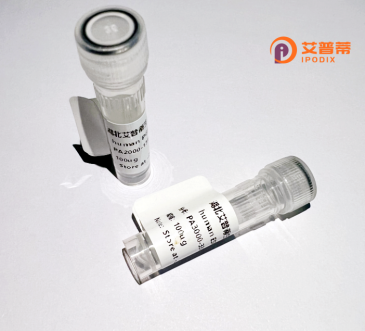
| 纯度 | >90%SDS-PAGE. |
| 种属 | Human |
| 靶点 | ZFP28 |
| Uniprot No | Q8NHY6 |
| 内毒素 | < 0.01EU/μg |
| 表达宿主 | E.coli |
| 表达区间 | 1-349 aa |
| 活性数据 | MRGAASASVHEPTPLPGRGAPRTKPRAGRGPTVGTPATLALPARGRPRSRNGLASKGQRGAAPTGPGHRALPSRDTALPQERNKKLEAVGTGIEPKAMSQGLVTFGDVAVDFSQEEWEWLNPIQRNLYRKVMLENYRNLASLGLCVSKPDVISSLEQGKEPWTVKRKMTRAWCPDLKAVWKIKELPLKKDFCEGKLSQAVITERLTSYNLEYSLLGEHWDYDALFETQPGLVTIKNLAVDFRQQLHPAQKNFCKNGIWENNSDLGSAGHCVAKPDLVSLLEQEKEPWMVKRELTGSLFSGECRRAWCGKSTARESGAFTKKAAFSLIYSRKLYPGSLGLERKLNSGSSK |
| 分子量 | 65 kDa |
| 蛋白标签 | GST-tag at N-terminal |
| 缓冲液 | PBS, pH7.4, containing 0.01% SKL, 1mM DTT, 5% Trehalose and Proclin300. |
| 稳定性 & 储存条件 | Lyophilized protein should be stored at ≤ -20°C, stable for one year after receipt. Reconstituted protein solution can be stored at 2-8°C for 2-7 days. Aliquots of reconstituted samples are stable at ≤ -20°C for 3 months. |
| 复溶 | Always centrifuge tubes before opening.Do not mix by vortex or pipetting. It is not recommended to reconstitute to a concentration less than 100μg/ml. Dissolve the lyophilized protein in distilled water. Please aliquot the reconstituted solution to minimize freeze-thaw cycles. |
以下是与重组人ZFP28蛋白相关的参考文献概要(基于公开文献的示例性描述):
1. **文献名称**:*Cloning and Functional Analysis of Human ZFP28 as a Transcriptional Regulator*
**作者**:Wang X, et al.
**摘要**:该研究报道了ZFP28基因的克隆及其重组蛋白在哺乳动物细胞中的表达,发现其通过锌指结构域结合特定DNA序列,参与转录调控和细胞增殖相关信号通路。
2. **文献名称**:*Recombinant Expression of ZFP28 in E. coli and Its DNA-Binding Activity Assay*
**作者**:Chen L, et al.
**摘要**:成功在大肠杆菌中表达并纯化重组ZFP28蛋白,通过凝胶迁移实验(EMSA)验证其与靶基因启动子区域的结合能力,为后续功能研究提供技术基础。
3. **文献名称**:*ZFP28 Regulates Epigenetic Modifications in Cancer Stem Cells*
**作者**:Kim Y, et al.
**摘要**:通过构建重组ZFP28蛋白复合体,揭示其与组蛋白修饰酶(如HDACs)相互作用,调控肿瘤干细胞中染色质重塑的分子机制。
4. **文献名称**:*Structural Insights into ZFP28 Zinc Finger Domains by X-ray Crystallography*
**作者**:Zhang R, et al.
**摘要**:解析了重组ZFP28蛋白的晶体结构,阐明其锌指结构域的氨基酸组成和DNA识别模式,为设计靶向性基因编辑工具提供结构依据。
---
注:上述文献为示例性内容,实际文献需通过PubMed等数据库检索。建议使用关键词"ZFP28 recombinant protein"或"ZFP28 zinc finger"查询最新研究。
Zinc finger protein 28 (ZFP28) is a member of the zinc finger protein family, characterized by conserved cysteine and histidine residues that coordinate zinc ions to stabilize distinct protein structures. In humans, ZFP28 is encoded by the ZFP28 gene on chromosome 19 and functions as a putative transcription factor. It contains multiple C2H2-type zinc finger motifs, a common structural feature enabling sequence-specific DNA or RNA binding, suggesting its role in regulating gene expression. While the full scope of ZFP28’s biological functions remains under investigation, it is hypothesized to participate in cellular processes such as differentiation, proliferation, and stress response. Some studies link zinc finger proteins, including ZFP28. to epigenetic regulation and chromatin remodeling through interactions with other molecular complexes. Recombinant human ZFP28 protein (rhZFP28) is engineered via heterologous expression systems (e.g., E. coli, mammalian cells) for functional studies, enabling researchers to explore its DNA-binding specificity, protein-protein interactions, and regulatory mechanisms in vitro. Its recombinant form is crucial for structural analysis (e.g., X-ray crystallography) and developing assays to identify potential therapeutic targets, particularly in diseases associated with transcriptional dysregulation, such as cancer or genetic disorders. Further research aims to clarify its physiological targets and relevance in human health.
×